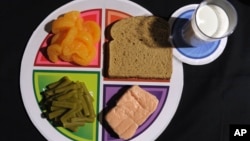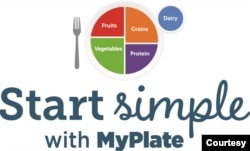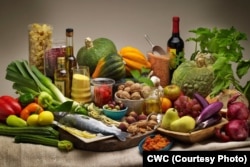Only one in four Americans know about the most recent government effort to get people to eat a healthy diet.
That information comes from a study released Tuesday by the National Center for Health Statistics.
The U.S. Department of Agriculture (USDA) introduced the logo, an image representing healthy eating, in 2011. It is called MyPlate. The image replaced the food pyramid logo the USDA used from 1992 to 2011. Nutrition experts criticized the food pyramid for placing too much importance on carbohydrates from grains and not enough importance on fats.
MyPlate uses a dinner plate with four colored sections for fruit, vegetables, grain and protein, with a smaller circle for dairy products, such as low-fat milk or yogurt. It encourages Americans to make half of their meals fruits and vegetables.
The study also found that about 10 percent of Americans had tried to follow the guidance of MyPlate. That means the program that costs about $3 million a year has not reached a big majority of Americans. Diet-related diseases such as obesity, diabetes and heart disease have continued to rise since MyPlate was introduced.
“This is currently the primary education tool that communicates guidelines for Americans,” said the study’s lead writer, Edwina Wambogo. She is a nutrition expert at the health information agency. “MyPlate should be doing a little bit better.”
Marion Nestle, a food policy expert, said the MyPlate program does not include an education program and does not deal with many foods Americans eat.
A USDA official said the agency’s proposed 2023 budget aims to increase spending on the program from $3 million to $10 million a year. The idea is to help the MyPlate program reach more people.
The recent study said people who called their diet excellent, very good or good were more likely to have heard of MyPlate than those who said their diet was fair or poor.
Dr. Vijaya Surampudi is a nutrition specialist at the University of California, Los Angeles. She said MyPlate leaves out important details about fats and the differences between vegetables. And Nestle noted that MyPlate fails to show that vegetables, grains, and dairy foods also contain protein.
The new study advises more research into why some groups are less likely to know about and follow government guidance. It also said additional research was needed to find out how best to reach people with poor diets.
But the answer is not so simple, Surampudi suggested. People know now that they should eat more fruit and vegetables. Beyond that, the message gets less clear.
“The minute it gets a little confusing, people shut down,” she said.
I’m Andrew Smith.
Jonel Aleccia wrote this story for the Associated Press. Andrew Smith adapted it for VOA Learning English.
__________________________________________________________________
Words in This Story
excellent –adj. very good, or of a very high quality
fair –adj. neither good nor bad
confusing –adj. difficult to understand
__________________________________________________________________
We want to hear from you.
We have a new comment system. Here is how it works:
- Write your comment in the box.
- Under the box, you can see four images for social media accounts. They are for Disqus, Facebook, Twitter and Google.
- Click on one image and a box appears. Enter the login for your social media account. Or you may create one on the Disqus system. It is the blue circle with “D” on it. It is free.
Each time you return to comment on the Learning English site, you can use your account and see your comments and replies to them. Our comment policy is here.













Forum